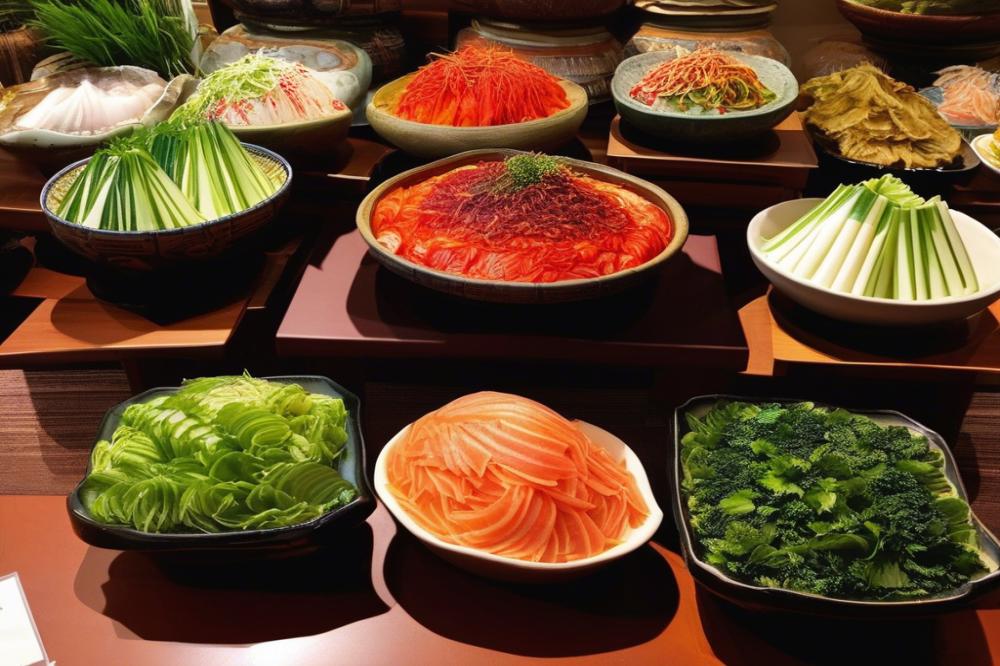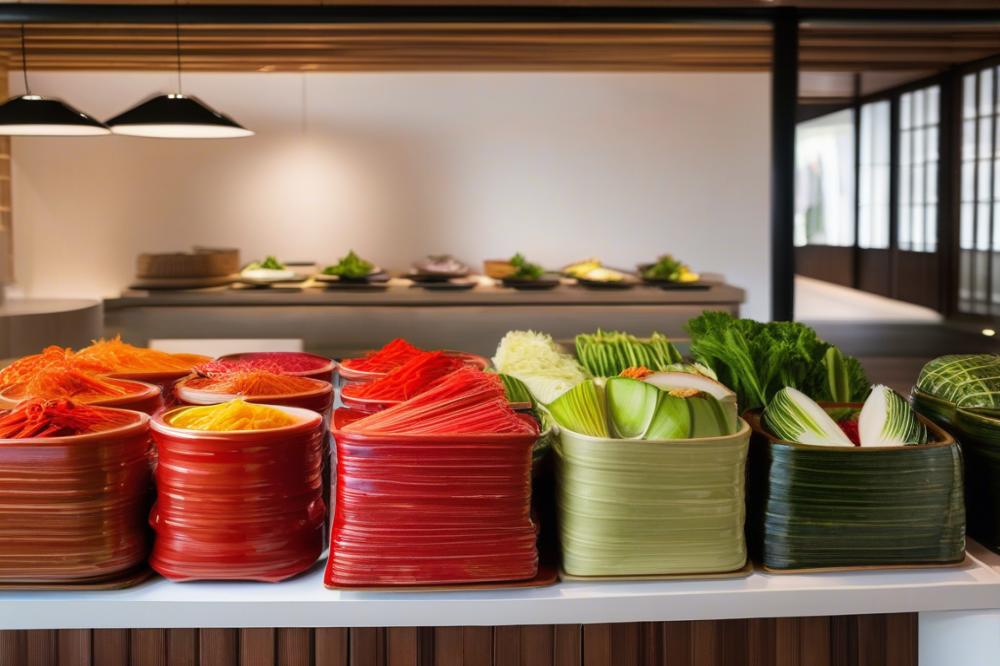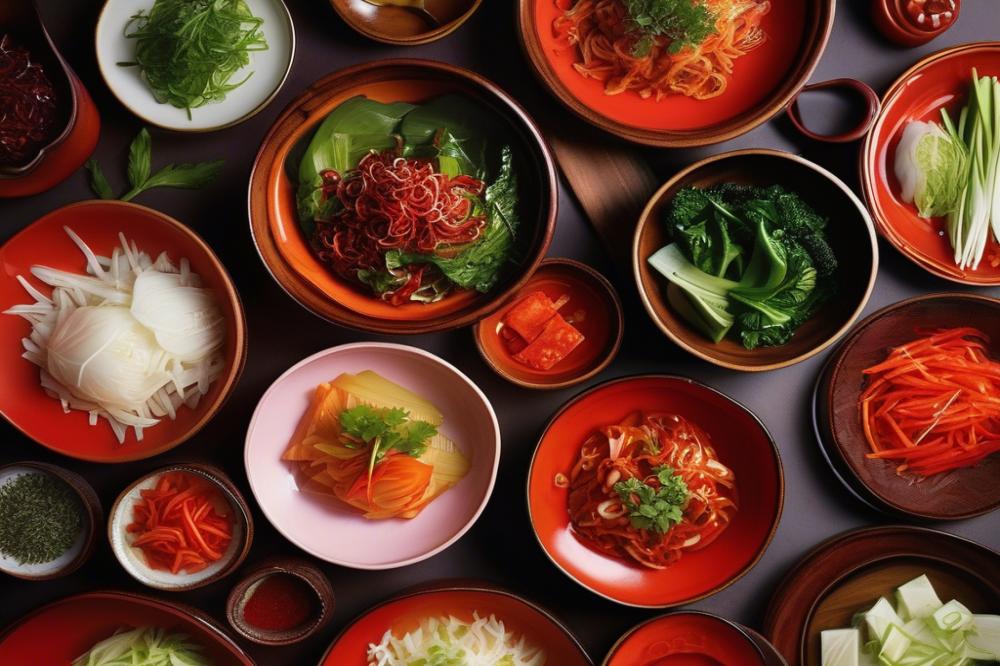Introduction to Traditional Kimchi
Kimchi holds a revered spot in Korean cuisine. This dish is not just a side item; it’s a fundamental part of many meals. Often made with napa cabbage, it captures a blend of flavors and traditions passed down through generations. Families have their own variations, making each recipe unique.
The fermentation process is vital for preserving vegetables. Through this method, food not only lasts longer but also develops rich flavors. Gochugaru, a special chili powder, adds spice and depth to the mix. As vegetables ferment, they contribute to a tangy taste that distinctly sets kimchi apart from other dishes.
Homemade Kimchi is more than just a tasty treat. It offers numerous health benefits which make it a desirable addition to any diet. fermented vegetables are known to enhance gut health, promote digestion, and boost the immune system. Including spicy kimchi in meals can lead to a variety of nutritional advantages, making it a wise choice for health-conscious individuals.
Making your own kimchi at home allows you to control the ingredients. Many enjoy experimenting with different homemade recipes, adding their personal touch. The joy of crafting this dish brings people together, as they learn about the tradition behind it. In essence, Traditional Kimchi goes beyond mere food; it embodies culture, health, and family bonding.
Understanding Traditional Kimchi

Traditional kimchi is not just a dish; it holds great significance in Korean culture. This fermented vegetable dish is often seen as an essential part of Korean cuisine. It goes beyond taste, representing togetherness and heritage in many households. Families often gather to prepare kimchi, especially during the fall harvest season, a time called ‘Kimjang’.
Across Korea, variations in ingredients and recipes exist, showcasing regional and personal preferences. For some, kimchi might include ingredients like radish, garlic, and green onions, while others may add seafood or even fruit. Each region has its own specialties. This diversity reflects the climate, available produce, and culinary traditions of different areas.
Napa cabbage and gochugaru play a crucial role in making spicy kimchi. Napa cabbage is the most common base. Its crunchy texture and ability to soak up flavors make it ideal for fermentation. Gochugaru, or Korean red pepper flakes, adds the heat and vibrant color that many exist for. Together, these ingredients create that distinctive flavor that lovers of kimchi adore.
The fermentation process transforms the simple ingredients into a tangy, savory delight. As vegetables ferment, their flavor deepens and changes, making each batch unique. fermented vegetables are known for their health benefits too. They can support digestion and boost the immune system, making kimchi a nutritious food choice.
Many handmade recipes include variations to cater to different palates. Some might prefer their kimchi with more spice, while others enjoy a milder taste. Regardless of the recipe chosen, each attempt captures a bit of the rich culinary history of Korea. Kimchi-making is a labor of love, reflecting individual creativity and tradition while maintaining the essence at its core.
Ingredients List and Nutritional Information

Making your own kimchi is a rewarding experience that combines vibrant flavors and health benefits. Here’s a detailed list of ingredients you will need:
- 1 large napa cabbage
- 1/2 cup sea salt
- 4 cups water
- 1 tablespoon grated ginger
- 1 tablespoon minced garlic
- 1 tablespoon sugar
- 1/4 cup fish sauce (or vegan alternative)
- 1/2 cup gochugaru (Korean red pepper flakes)
- 4 green onions, chopped
- 1 small carrot, julienned
Every ingredient plays a role in the fermentation process and overall taste of your kimchi recipe. Each component contributes unique flavors and textures to the final product. Let’s look at the nutritional information for these ingredients:
Nutritional Breakdown
The napa cabbage is rich in vitamins C and K, providing about 20 calories per cup. This leafy vegetable offers health benefits, including improving digestion.
Sea salt, although used for fermentation and flavor, adds sodium to the dish. Moderation is key, as a 1/2 cup can significantly increase sodium intake.
Water doesn’t contribute calories but is essential for the salting process, helping to draw moisture from the napa cabbage.
Ginger has about 5 calories per tablespoon and provides anti-inflammatory properties. This spice adds warmth and depth to your spicy kimchi.
Garlic, with 4 calories per tablespoon, is known for its immune-boosting qualities. Its strong flavor enhances the overall taste profile.
Sugar, a simple carbohydrate, offers about 48 calories per tablespoon. It helps balance the spiciness while aiding fermentation.
Fish sauce, which can add around 24 calories per tablespoon, contributes umami flavor. A vegan option made from fermented soybeans is available for plant-based diets.
Gochugaru, usually around 30 calories for 1/2 cup, delivers the signature heat of Korean cuisine. This ingredient is essential for that vibrant color and spicy kick.
Green onions are low in calories, at about 5 per 4 chopped ones, yet they provide a burst of freshness. Their flavor balances well with the other ingredients.
Finally, the carrot, which has about 25 calories when julienned, adds sweetness and crunch. It also adds color and nutritional value to your homemade recipes.
Altogether, these ingredients blend to create a flavorful and nutritious dish. Fermented vegetables such as kimchi are not only delicious but also promote gut health. The combination of salty, sweet, and spicy elements contributes to a unique culinary experience.
Step-by-Step Kimchi Recipe

Making traditional kimchi at home is a rewarding journey. Start by preparing the base, which is napa cabbage. Cut the cabbage into quarters and rinse it well. Place it in a large bowl and sprinkle salt generously between the leaves. This salting process draws out moisture and flavors the cabbage. Let it sit for about two hours. Turn the cabbage occasionally to ensure even salting. After two hours, rinse the cabbage thoroughly under cold water to remove excess salt. Soaking in water for a bit can help balance the saltiness.
Next, it’s time to create the spice paste. In a bowl, combine gochugaru, minced garlic, grated ginger, sugar, and fish sauce. The gochugaru, a staple in Korean cuisine, gives that characteristic spiciness and vibrant color. Mix the ingredients until there are no dry spots. The sugar helps enhance the flavors while balancing the heat of the gochugaru. This paste will become the heart of your spicy kimchi.
Now, prepare additional vegetables to enhance the texture and taste. Thinly slice carrots, green onions, and radishes. The variety will add both crunch and flavor. Once everything is chopped, combine the vegetables with the spice paste. Ensure every piece of vegetable is well-coated in the mixture. This step is crucial as it layers the flavors throughout your fermented vegetables.
After mixing well, it’s time to pack the kimchi into jars. Use glass containers for storage. This method allows you to see the fermentation process as it unfolds. Press the mixture down firmly to minimize air gaps. Leaving some space at the top is necessary because the mixture will expand as it ferments. Seal the jars tightly to keep out unwanted elements.
Understanding the fermentation process is important for delicious results. Place your jars in a cool, dark location. The ideal room temperature should be between 60°F and 75°F. After about one to two days, check the kimchi. You’ll notice bubbling and a tangy aroma. This tells you that fermentation is underway. If you prefer a stronger taste, allow it to ferment for longer, up to a week or more, checking regularly.
For optimal flavor and texture, consider some important tips. Choosing high-quality gochugaru influences the taste significantly. Additionally, feel free to experiment with different vegetables based on what you have. Some people like adding apples or pears for sweetness. Remember that the fermentation period will change the flavor over time, becoming more robust with each passing day. The health benefits of fermented foods are well-known, making this homemade recipe both delicious and nutritious.
Health Benefits of Traditional Kimchi

Fermented vegetables offer a powerhouse of nutrients. In particular, napa cabbage, which is the main ingredient in many kimchi recipes, is low in calories yet high in vitamins A and C. Such vegetables are rich in dietary fiber, promoting digestion and overall health. The vibrant mix of spices, especially gochugaru, adds a unique flavor while contributing antioxidants that can fight free radicals in the body.
Probiotics play a key role in gut health. These live microorganisms are found in fermented foods and help maintain a balanced gut flora. Regular consumption of spicy kimchi can boost the diversity of beneficial bacteria in your digestive system. A healthy gut is essential for nutrient absorption and proper immune function, making homemade recipes like kimchi a valuable addition to your diet.
Balancing your meals goes beyond just the primary ingredients. Incorporating kimchi into your day can enhance nutrient intake. It complements a variety of dishes, from rice to tacos, adding flavor and nutrition. This traditional side dish can also help in weight management. Its low-calorie nature, combined with the satiating effects of fiber, makes it an excellent choice for those watching their caloric intake.
Storing and Enjoying Your Homemade Kimchi
Best Practices for Storing Kimchi
Storing kimchi properly is key for maintaining its flavor and crunch. A glass or ceramic container is your best option. Make sure the container is airtight. This keeps the kimchi from drying out or absorbing unwanted odors. Keep it in the refrigerator once it is fermented to your liking. The cool temperature slows the fermentation process, which can affect the taste over time. Spicy kimchi can last several months when stored this way. However, the flavor will intensify as it sits. For those who want a less sour taste, consume it sooner rather than later. Remember, refrigerated kimchi can become a bit softer, but it remains delicious.
How to Incorporate Kimchi into Meals and Recipes
Using kimchi in meals is simple and fun. Many enjoy it as a side dish that complements various dishes. Try adding it to rice bowls or using it in tacos. Grilled cheese sandwiches can transform with a layer of kimchi. Stir-frying vegetables with this fermented vegetable can bring a vibrant taste. Soups and stews benefit significantly from a spoonful of kimchi added while cooking. Bowls of ramen become more exciting with the addition of spicy kimchi. This adds both flavor and health benefits to your meal. Overall, the versatility of kimchi makes it an easy addition to your everyday cooking.
Popular Korean Dishes That Pair Well with Kimchi
Korean cuisine features many dishes that taste even better with kimchi. Bibimbap is a colorful dish that combines rice, vegetables, and a fried egg. Adding kimchi enhances its flavors wonderfully. Another favorite is kimchi jjigae, a savory stew that includes tofu and pork. This dish highlights the robust taste of fermented napa cabbage. Fried rice, or kimchi bokkeumbap, transforms into a comforting plate packed with flavor. Many people enjoy using kimchi in kimbap, a popular seaweed rice roll. Savory pancakes, called kimchi jeon, also showcase this ingredient’s uniqueness beautifully. Each of these dishes offers a chance to experience the delicious taste of kimchi alongside traditional Korean fare.
Final Thoughts on Making Kimchi
Crafting kimchi at home is a fulfilling experience. This journey begins with selecting fresh ingredients and carefully mixing them with spices and seasonings. Each step enhances the flavors, leading to a tangy and crunchy dish that symbolizes Korean cuisine. Not only is it a staple on many tables, but it also holds cultural significance as a dish that has connected families for generations.
Engaging with traditional practices like this brings many rewards. Fermented vegetables are known for their health benefits, aiding digestion and boosting immunity. By making kimchi, you participate in a rich heritage while enjoying the nutritious aspects it offers. The fermentation process is not just a method; it’s a celebration of flavor and preserving food during difficult seasons.
Exploring variations and flavors can be incredibly exciting. Consider using different vegetables or spices to create a kimchi that reflects your preferences. Whether you enjoy it spicy, tangy, or a little sweet, there’s no wrong way to personalize your creation. Try adding garlic, ginger, or even fruits like pear to discover what you like best.
As you embark on your kimchi-making adventure, remember that this is just the beginning. Each batch holds the potential for uniqueness. Enjoy the journey and keep experimenting. Your kitchen can become a space of discovery, leading you to beloved family recipes or new favorites. Embrace the art of fermentation and savor every crunchy bite.



